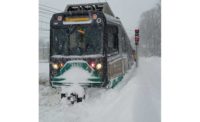An ongoing Boston Green Line track repair program has reduced derailments, but an aggressive maintenance program, improved safety standards and more investment are critical for avoiding more derailments and other system failures, according to a state transportation oversight report.
The Massachusetts Bay Transportation Authority Green Line track maintainers are “no longer in a maintenance mode but in ‘repair the issue just enough’ to return to a restricted service mode … not sustainable in the long run,” stated an oversight report last fall.
Despite fewer derailments, the report states that track geometry needs attention. Green line track standards do not appear to be strict enough for the tight tolerances required by the low-floor cars, it notes.
Since summer 2016, MBTA crews have replaced 28,450 ft of track and approximately 1,020 ties and tie plates, reducing track defects by more than 50%, the authority notes.
“These and other short-term improvements set the foundation for core infrastructure work, which will be done in the months and years ahead as part of a [$120-million] comprehensive Green Line Track Renewal Plan,” says an MBTA spokesman.
Green Line track replacement and maintenance work in the last 20 months have led to the lifting of seven of 58 previous speed restrictions at several locations where work was performed, he adds.
Lifting the speed restrictions has improved travel times by up to eight minutes, the spokesman says.
Track maintenance work has reduced derailments, the spokesman says. Between 2014 and 2016, 19 derailments occurred on the Green Line. The MBTA had three Green Line derailments in 2017, all caused by human error, not track conditions, and one derailment in January caused by snow.
The report notes that “by adjusting and realigning track crossings, utilizing modern removable crossing panels, and standardizing the infrastructure to one rail size, the MBTA will achieve lower maintenance costs and remove the burden of trying to maintain and match parts within a mixed infrastructure component system.”
Jim Lambrechts, professor of civil engineering at Wentworth Institute of Technology, says the challenge is how to keep the aging infrastructure in service with trains arriving every 45 seconds. “It’s so heavily used that you can’t shut it down, so we have to rely on modern technology to accomplish repairs more quickly. Modern society is maxing out the capacity of systems.”





Post a comment to this article
Report Abusive Comment